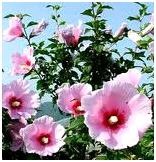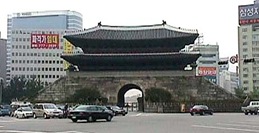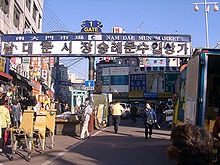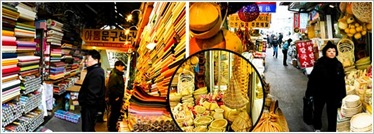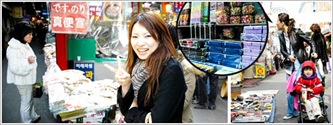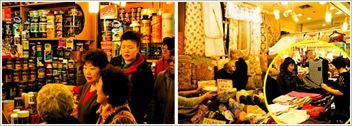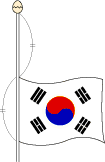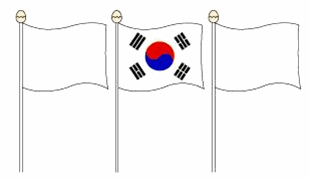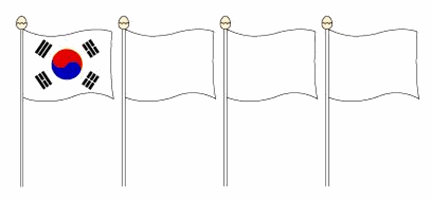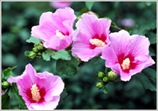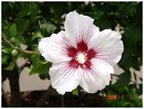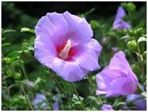What comes to your mind instantly, when someone mentions the word ‘Namdaemun’ to you? Namdaemun Market? No, I was thinking of something more valuable, like a National Treasure.
I believe you must be curious to hear about the legend of the Mugunghwa from last week, so I shall not waste any more time and tell you about it now.
The Legend of Mugunghwa
There once lived a beautiful and warmhearted woman. Not only was she pretty, but she was good at writing poetry, calligraphy, painting and singing. Many of the men in the village were in love with her and wanted to marry her, but she chose to marry a poor, blind man. Everyone was curious as to why she chose to marry this blind man when she could have had any man in the village. As they were poor she had to go out to work doing the menial tasks but she never even complained. She was a good wife and took very good care of her husband. The villagers took pity on her with all the hardship she had to suffer. The story of the beautiful woman and her blind husband spread widely until it reached the ears of the village administrator. He decided to see for himself and sent for her. When he saw her, he was completely smitten by her. She was so beautiful and well behaved that he wanted to marry her immediately, although he knew that she was already married. He made her a proposal of marriage, but the woman refused, and told him that she could not do so as she was already married.
He pleaded with her and promised her that he would do anything for her if she would marry him. He even tried to lure her in many ways but she cried and pleaded to go home. However much she cried it was of no avail, instead the administrator got angry and threatened her that if she didn’t obey him, he would kill her. He just couldn’t believe that she would want to go back to a blind man.
Then she cried out that she couldn’t marry him even if she were to die and that she would rather die which angered him even more. He immediately ordered her to be killed. Before she died she requested that she be buried under the fence of her house.
The following year, a flower plant grew up under the fence where the innocent woman was buried. This plant surrounded the fence and gave bloom to very beautiful flowers. This is the Mugunghwa, The Rose of Sharon. To take care of the blind husband, she was reborn as a tree. All the people thought of this Rose of Sharon as the spirit of the beautiful woman who died for her husband. It’s only a legend so it’s up to you to believe it or not.
This was the answer I was expecting to get from you with regards to my question earlier on, the Namdaemun Gate. One of the most iconic South Korean landmarks, it is located right in the center of downtown Seoul, in Jung-gu between Seoul Station and Seoul City Plaza, just next door to the Namdaemun Market. But, there can’t be a gate unless there’s a wall, so today I shall be taking you back to the early 14th Century in the history of Korea to find out more about the gate and the wall.
King Taejo, the first king of the Joseon Dynasty (1392-1910) was a man of vision. He moved his capital to Seoul in 1394. A city wall was in the mind of the king even before he picked the capital city for his new kingdom. He said that “a city wall was a country’s fence that kept out violent enemies and protected the people. Thus, it should be erected.” After he announced that Hanyang (present-day Seoul) would be the new capital later that year, Taejo ordered the construction of Jongmyo, a shrine for ancestors and Gyeongbok Palace, a home for himself. And to complete his vision, he initiated the building of a protective city wall. Taejo ordered experts to find a good site for the wall. Seoul is blessed in that it is surrounded by mountains, on its four sides, the Bugaksan to the north, Namsan to the south, Naksan to the east, and Inwangsan to the west. The wall was built connecting these four mountains. Stone walls were built on the mountains themselves and earthen walls on the flatlands between them. Most of this original wall was completed in 1396, although it was a few years later that all the gates were completed. It was 18.2 kilometers long and 6.1 meters high. Four major gates and four smaller ones were also built to control passage in and out of the capital.
With modernization and the beginning of Japanese colonial period, (1910-1945) the city wall became an obstacle to progress. When the Japanese officially annexed Korea in 1910, they set about devising plans to modernize Korea, and as a result nearly all the city wall that stood on flatland was torn down. Today only small parts of its remnants remain.
The Namdaemun Gate was constructed in 1398 during the reign of King Taejo in the early Joseon Dynasty. The structure was rebuilt in 1447 during the reign of King Sejong. A major construction on the gate was done in 1479 during the reign of King Seongjong and has been renovated several times since.
It was once one of the three major gateways through Seoul's city walls, the others being the East Gate (Dongdaemun) and the now-demolished West Gate in the Seodaemun-gu district, named after the old gate.
Before the 2008 fire, Namdaemun was the oldest wooden structure in Seoul. The city gate made of wood and stone was originally used to greet foreign emissaries, to control access to the capital city, and to keep out tigers in the area. The meaning of Sungnyemun, its original name, is Gate of Exalted Ceremonies whereas Namdaemun means Great Southern Gate. The gate is located in the center of the stone wall, and a two-storied pavilion with five compartments on the front and two compartments at the sides was constructed on top of the gate.
The city wall became an obstacle to progress and sections of the wall were demolished, ostensibly "to make the traffic system more efficient."
Namdaemun was extensively damaged during the Korean War and was given its last major repair in 1961, with a completion ceremony held on May 14, 1963. It was designated "National Treasure No.1" on December 20, 1962.
The Gate was renovated again in 2005 with the building of a lawn around the gate, before being opened once again to the public with much fanfare on March 3, 2006.
A fire broke out on February 10, 2008 and severely damaged the wooden structure at the top of the Namdaemun gate. It was a case of arson
So you can see that the Namdaemun Gate played an important role in the history of Korea. But now it will no longer be known as the oldest wooden structure in Seoul anymore.
Since we are in the vicinity we might as well pay a visit to the Namdaemun Market.
Namdaemun Market is the largest traditional market in Korea with over 10,000 stores that line the streets around Namdaemun Gate. Namdaemun Market is renowned for its vast size and the variety of goods it offers. Namdaemun Market opens from 11:00pm to 3:00am.You can find almost anything under the sun here and if you can’t find what it is you’re looking for here, chances are you won’t find it anywhere else in Seoul.
Namdaemun Market sprawls over 24 blocks, with each block featuring a different specialized shopping zone, the market's clothing zone being the largest. More than 6,000 of the 10,000 shops that make up the market are clothing and accessories stores. Because many domestic retailers and foreign buyers come here to purchase goods at wholesale prices to resell in their stores, Namdaemun Market is considered to have a huge influence on the fashion industry. The ladies’ wear section is particularly popular, offering quality fashions in casual wear, formal wear, leisure wear and much more. But ladies’ wear is not the only type of clothing that is widely available; as much as eighty percent of all children’s wear traded in Korea goes through the children's wear section in Namdaemun Market. If you want to shop for children’s wear, it is best to arrive early since the shops here close at about 3 or 4 p.m.
Although the shops are small, most of them produce the goods they offer themselves, allowing for customers to purchase goods directly from the manufacturers at wholesale prices. As there are many shops selling the same things it is best to compare prices before making your purchases, so that you’ll get the best deals.
Namdaemun Market is an absolute haven for street shoppers. The area’s myriad walkways are flanked with streams of shops and cluttered stands selling everything from inexpensive clothing, accessories and glasses to cameras, imported foods and tableware. Much of the market is outside, but there are also many stores which line the streets. With all this selection and discount prices, it is no wonder why Namdaemun attracts the crowds.
Still haven’t seen anything you like? Why not try the shops in the underground shopping area?
At the north of the market (the entrance from exit 5, line 4 Hoehyeon station), there are stores lining the street selling imported goods and accessories. This is a particularly good area to buy souvenirs, so it will be packed with tourists.
And no shopping experience can be complete without a little eating. All this walking deserves a good rest and what better than to take in the experience of Korean eateries, or pojangmachas, and sample some traditional delicacies like kimbap, noodles and a host of delicious pan-fried foods.
And with this I bid you happy shopping and don’t get lost. I nearly forgot, it’s best you carry cash with you, as most of the shops here don’t take credit cards. See you again next week.
Special thanks and appreciation to the following:
Photos and articles © courtesy:
http://en.wikipedia.org/wiki/Namdaemun
http://forum.koreansentry.com/a/seoul-city-wall_post984.html
http://www.visitseoul.net/en/seoul-shopping/namdaemun-market.jhtml

